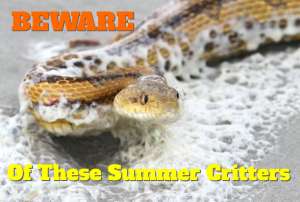
On Wednesday May 6th, an unexpected critter was spotted among the sea foam on Jacksonville Beach, Florida.
A surfer spotted the snake and posted pictures on 911surfreport.com. Needless to say, this sighting caused quite a bit of panic in the community of beachgoers. The slithering party crasher is believed to have been a yellow rat snake, non-venomous and mostly harmless.
This snake was not a native water snake. It is thought to have been brought down by the unusually high tide from the trees or grassy areas near the beach. Other theories suggest that the rat snake was dropped in the water by a bird of prey that bit off more than it could chew. Either way, a happy ending for the friendly reptile. After capturing the snake, animal control officers returned it safely to the sand dunes on the beach.
This causes us to consider what animals are coming out as the weather warms up. While this beached reptile was non-venomous and relatively harmless, many other warm weather critters are not as peaceful as the surfing snake.
With summer hot on our heels, it’s time to take advantage of the clear skies and sunny days, by getting outside and soaking up some rays. But wherever you are, there will most likely be predators and dangerous animals to contend with. Whether you’re exploring the ocean, hiking through the rugged mountains, or camping in the desert, here are a few common creatures that could cause you trouble this summer season.
Mosquitoes
Mosquitoes, the bane of humans everywhere. Not only are these pesky insects universally annoying, they can actually be really dangerous. These pets can transmit many potentially fatal diseases including malaria, encephalitis, West Nile virus, and yellow fever.
While it’s impossible to avoid mosquito bites entirely, here are a few natural ways we’ve found helpful in repelling these summer bloodsuckers:
Commercial bug spray is loaded with chemicals and in the end will harm you more than the bite itself, so make your own with this easy bug repellent recipe.
Add distilled water to an empty (and clean) spray bottle to the halfway mark.
Fill the spray bottle until it is almost full with witch hazel.
Add 60 drops of essential oils and shake well. Use rosemary, clove, or eucalyptus.
Cover your arms, legs and any other part of exposed skin before pursuing any outdoor activity.
If you spend a lot of time lounging on your porch or patio, make your outdoor living area a little more human friendly with these simple tricks.
Setting up a fan is a great way to push mosquitoes away. Mosquitoes are attracted to the moving blades, but then get sucked up by the air and killed by the blades. Position fans where you spend the most time, such as on covered porches, gazebos, etc.
Citronella or any other strong smelling herbal candles are highly offensive to mosquitoes. The sight of the flame and scent from the candles is enough to send even the largest and most determined mosquitos packing. Light the candles when you’re out on your patio, especially during twilight when mosquitos are most persistent.
If all else fails and you happen to get bitten, try any of these methods to ease the pain and reduce swelling.
Ice—Apply an ice pack to the area to help reduce swelling and pain.
Tea tree oil—Apply tea tree oil directly to the bite.
Apple cider vinegar—Spray or wipe apple cider vinegar on to the area to ease itching and pain.
Raw honey—Dab a glob of honey on the bite and rub it into your skin.
Tea bag—Make a pot of tea then place the tea bag on your bite. This will reduce redness and itching.
Baking soda—Make a paste with baking soda and water. Rub the paste on your bite to draw out the itch.
Witch hazel—Rub witch hazel directly onto your bites.
Mint—Rub crushed mint leaves onto your skin to reduce itching and further protect you from mosquitoes.
Banana—Place a banana slice on your bite to ease the pain.
Aloe vera—Rub aloe vera gel onto the bite to reduce redness and swelling.
Ticks
Ticks are the silent predators. They are usually found in grassy or wooded areas. Ticks are dangerous because they are the main carriers of Lyme disease and can transfer it to humans and pets.
Lyme disease is caused by the bacterium Borrelia burgdorferi and is carried by deer ticks or black-legged ticks. It is the small ticks that matter most; the juvenile ticks, which are only slightly bigger than a period at the end of a sentence, are the most dangerous.
Early diagnosis and treatment of Lyme disease is essential to avoid complications that can last a remarkably long time. One of the big problems with diagnosis is training medical professionals to recognize the rash caused by the disease.
Most people think that the rash must have a bullseye appearance to indicate the disease, but this is not true. The rash actually resembles such things as dermatitis, spider bites, lupus or other common skin conditions, which makes it extremely difficult to spot.
Other signs of Lyme disease include flu-like symptoms such as fatigue, low-grade fever and joint pain. If you feel that you may have been bitten by a tick and contracted Lyme disease, you can ask your physician for a lab test to identify antibodies. These tests are only reliable about three weeks after an infection.
Symptoms of Lyme disease that may not appear until weeks, months or even years later include arthritis, numbness and pain, and irregular heart rhythm. Early diagnosis can prevent long-term complications that do not always respond favorably to antibiotics. Some people can develop chronic Lyme disease which can interfere with their quality of life.
In order to prevent the contraction of this harmful disease but still enjoy all the experiences that nature has to offer, take every precaution you can before setting out on an outdoor adventure.
Wear light-colored clothing.
Wear a hat and a long-sleeved shirt.
Tape the area where your socks and pants meet.
Tuck pants into boots.
Stick to the center of a trail if you are hiking.
Avoid areas of high grass.
After being outside, remove clothing and wash and dry it at a high temperature.
Inspect your body carefully, especially the hairline area, belly button, underarm area, behind your knees and your waist.
Check all gear that you took outside with you before bringing it into the home.
Check pets carefully.
Even better, whip up this all-natural tick repellent for extra protection.
Ingredients:
- 2 tbsp coconut oil
- 1 tbsp aloe vera gel
- A small, empty bottle
- 25 drops of lavender essential oil
- 25 drops of geranium essential oil
Directions:
Pour the coconut oil into the small bottle (liquid form — heat it slightly if needed).
Add the aloe vera gel and shake until the oil and aloe vera mix.
Add the essential oils and shake again for about 30 seconds.
Apply generously to all exposed skin before you go outside.
Snakes
Probably one of the most overt predators that a person may encounter while outdoors is a snake. While it’s hard to completely avoid snakes, there are steps you can take to limit your unpleasant interactions with them.
Always try to stay on the trail when hiking so you can clearly see what you are stepping on. If you have to venture off the trail into high grass or weeds, find a long stick and probe the ground in front of you. Snakes aren’t always hiding though, they will sometimes curl up directly on the path to sun themselves.

Don’t just look at the ground either, snakes like to hang out in trees — often we forget to look for these slithering reptiles at eye level and above. Be constantly aware of your surroundings at all times.
Be extremely careful when sticking your hand into a hollowed out log, cave, or crevice in the rocks. While snakes like to sun themselves, they are equally fond of cooling off in a dark area on blazing summer days. Many other predators also hide in dark places. So maybe try to avoid sticking your hand in them, as a general rule.
Really, anytime you’re exploring a wilderness area, you should wear heavy boots and long pants. But this is especially true when dealing with snakes. The ankle is a favorite strike place of snakes, so pants tucked into your boots will protect you from this and other unsavory encounters, including poison ivy/oak, ticks, briars and chiggers.
While you can take every precaution to avoid the unfortunate event of a snake bite, accidents do happen, and sometimes a bite is unavoidable. Here are a few tips for the best way to respond to such a bite.
First and foremost, seek medical attention immediately! All snake bites are dangerous, even if you’re pretty sure the snake wasn’t venomous. Postpone your camping or hiking trip and get to the nearest hospital as soon as possible. There are steps you can take before you get there though.
Wash the bite with soap and water to remove the snake’s saliva.
Keep the bitten area below the heart to slow the flow of venom.
Remove any jewelry to prevent cutting off the circulation.
Stay calm! The quicker your heart beats, the faster the venom is circulated throughout your body.
Do not apply ice to the bitten area, ice can cause tissue and skin damage.
Don’t let fear stop you from having fun
All you can do is take precautions. Be sure to not let your fear of summer predators stop you from doing what you love. Sometimes it’s impossible to avoid every unpleasant thing in the wild, and the good — the beauty of nature and the healthiness of fresh air — far outweighs the bad. Don’t stress this summer, and have an amazing time spending your days in the great outdoors!
-The Alternative Daily
Sources:
http://www.coloradonewsday.com/news/regional/104560-snake-spotted-at-beach-in-mayport-florida-by-surfers.html
http://www.artofmanliness.com/2008/07/15/complete-guide-to-snakes-part-2
http://www.palmbeachpost.com/news/news/national/large-snake-washes-ashore-beach/nmDD6

